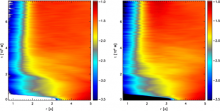
Abstract
In this paper we evolve magnetized and unmagnetized circumbinary accretion disks around supermassive black hole binaries in the relativistic regime. We use a post-Newtonian expansion to construct an analytical spacetime and determine how the order of the post-Newtonian (PN) expansion affects the dynamics of the gas. We find very small differences in the late-time bulk dynamics of non-magnetized hydrodynamic evolutions between the two spacetimes down to separations of approximately $40GM/c^2$ where $M$ is the total mass of the binary. For smaller separations, the differences due to PN-order become comparable to differences caused by using initial data further from equilibrium. For magnetized gas, MHD dynamics, which drives the accretion dynamics, tends to mask all higher order PN effects even at separations of $20GM/c^2$, leading to essentially the same observed electromagnetic luminosity. This implies that our calculations of the EM signal may be robust down to small binary separations. Our investigation is the first to demonstrate how the level of PN accuracy affects a circumbinary disk's evolution and informs us of the range in separation within which to trust the PN approximation for this kind of study. We also address the influence the initial conditions and binary separation have on simulation predictions.